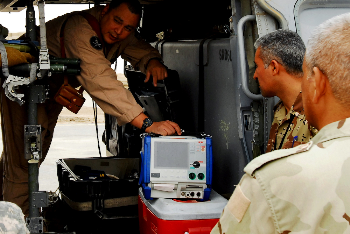
For the U.S. Navy, providing trauma care for Marines and sailors deployed in remote locations poses a daunting challenge. When a person suffers major trauma — a bullet or shrapnel wound, a serious head injury, a severe burn — rapid access to high-level medical care can literally be a matter of life and death. But Navy and Marine Corps personnel often suffer such injuries in places and situations where such care may be many hours away.
What’s needed is a way to make the clinical expertise and capabilities of a critical care center available to patients while they’re being evacuated. And that’s why the
Office of Naval Research has teamed up with biomedical scientists from UTMB to develop the Automated Critical Care System.
The concept behind the ACCS is simple; it’s intended to be a “cruise control” for critical care, able to automatically sense and respond to a patient’s condition with appropriate intravenous fluid support and emergency drugs. The reality is a bit more complicated; it’s a “system of systems” that will continuously take vital data with non-invasive monitors, determine the proper therapeutic support for a particular type of trauma, and deliver fluid and drugs in precise quantities intravenously.
“We’re working with trauma surgeons and intensive-care specialists to translate best-practice principles and rules for emergency and critical care into computer algorithms,” said
UTMB professor George Kramer, principal investigator on the project. “We’re providing those systems with input from the new generation of non-invasive ‘smart monitors,’ which can detect a wide variety of vital information, including data that previously required invasive catheters and blood sampling. Finally, we’re supplying fluid therapy with compact, highly efficient pumps that are just entering the market.”
The entire package is expected to be no larger than a backpack, making it possible to use it to support casualties in the limited space available inside a crowded aircraft or ground transport. Marine Corps requirements specify that it be able to autonomously manage a critically injured casualty for up to 6 hours.
According to Kramer, the ACCS will be able to operate in both “decision assist” and “fully automated” modes. In the first, the system will provide treatment recommendations that can be accepted or rejected by a local medic or telemedicine caregiver; in the second, it will manage the casualty without human input.
“We want to greatly reduce the work load on the caregiver, making it possible for him or her to care for multiple casualties during an evacuation,” Kramer said. “We also believe our technology could make a critical difference in a mass-casualty event, when there aren’t enough caregivers to go around.”
In a civilian trauma center, a full team of doctors and nurses often begins treating a trauma victim within minutes of injury. But the treatment of combat casualties and civilian trauma care are not as different as it might seem, said Dr. Bill Mileski, a co-investigator on the ACCS project, director of the UTMB emergency department and chair of the ten-member panel developing ACCS treatment algorithms.
“The fundamental clinical challenge is the same: assessment, stabilization and resuscitation by individualizing therapy to the specific mechanism of injury and patient status,” Mileski said. “We’re addressing that challenge in our system by developing trauma care algorithms that draw on years of experience and state-of-the-art best practices.”
UTMB is in the first year of a four-year $2 million ONR development contract on the ACCS. UTMB researchers have been laying the groundwork for the system with Navy- funded physiology and biomedical engineering studies since 2001. Four Galveston-Houston startup companies have formed around UTMB inventions related to smart monitors and computerized decision support for trauma care.
“While this project seems revolutionary, it’s really evolved over 12 years,” Kramer said. “It’s exciting to see all that work finally coming together into something that could make a real difference for trauma care and be applicable for wounded warriors.”
VIDEO LINK